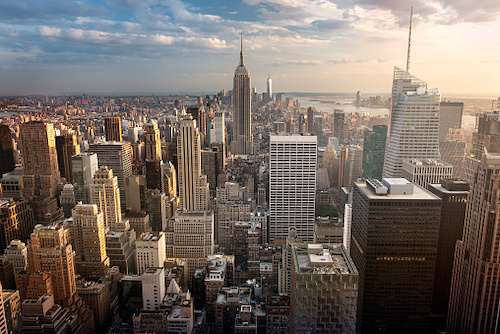MONDAY, DECEMBER 16, 2019
The New York City Department of Buildings formally announced last month that the city’s new green roof laws took effect Nov. 15.
Local Law 92 and Local Law 94 require that all new buildings and all existing buildings undergoing major roof renovations to have a solar photovoltaic system, a green roof system or a combination of the two. The systems must cover 100% of any applicable roof.
“In New York City, we are not shirking from the challenge of climate change,” said Buildings Commissioner Melanie E. La Rocca.
“These new laws are a sea change in how we approach new buildings, and help make our city a national leader in reducing emissions. With the biggest energy team in the country, we are ready and able to be a resource and provide technical assistance to the real estate industry as we work together to tackle this challenge head on.”

 |
| ventdusud / Getty Images |
|
The New York City Department of Buildings formally announced last month that the city’s new green roof laws took effect Nov. 15. |
As of Nov. 15, all new application filings for new building projects and alteration projects that include vertical and horizontal enlargement or replacement of the entire roof deck, must include a form certifying their compliance with Local Laws 92 and 94 prior to plan approval from the Department.
History
The New York City council approved a package of bills and resolutions, including Local Laws 92 and 94, in April.
Local Law 92 was originally introduced by Council Member Donovan J. Richards on Jan. 31, 2018, and looks at residential buildings that are five stories or fewer and have less than 100 square feet of rooftop space. In this instance, the building would be required to install a green roof option or solar-electricity-generating system, depending on the structure’s dimensions.
Richards' bill also requires that the Department of Housing Preservations and Development perform a study on the potential impact of green roofs and building affordability.
Local Law 94 was introduced by Council Member Rafael L. Espinal, Jr. on July 7, 2018, and promotes an energy-efficient building practice, which requires that all commercial and manufacturing buildings are required to install an energy-efficient green roof.
“It’s important for New Yorkers to know that green roofs are going to play a major role in making our city a more livable city from lowering the temperatures of our communities to improving air quality across the city,” said Espinal.
“The implementation of Local Laws 92 and 94 of 2019 will ensure that New York City is at the forefront of the transition to a cleaner and greener future for all New Yorkers,” said Richards.
“Utilizing valuable rooftop space to continue reducing our carbon emissions will also help reduce energy costs, improve stormwater management and make our city more livable for generations to come. We look forward to seeing more and more innovative ways to enhance green infrastructure as buildings begin to pop up in compliance with these laws and I’d like to thank Council Member Espinal for his commitment to green energy as well as Mayor de Blasio, Commissioner La Rocca and Director Chambers for their partnership on the Climate Mobilization Act.”
The passing of the green roof legislation came on the heels of Mayor Bill de Blasio’s release of $14 billion act, OneNYC2050—Building a Strong and Fair City. The new legislation will cover new buildings, as well as those undergoing major renovations, and is intended to cut the city’s greenhouse emissions by 30% by 2030.
There are two major parts of the initiative that impact the building and construction industry. Those include:
In the requirements of the new bill package, the green roofs are slated to help mediate the urban heat island effect, aid in cutting energy costs, help absorb air pollution, reduce stormwater runoff, provide soundproofing and promote biodiversity.
“The implementation of the law expanding green roofs is a win for our environment, our economy and our communities,” said Espinal.
“At a time when national policy seems to turn its back on our planet, it is up to cities like New York to lead the fight against climate change. To do that, we have to adopt policies that take advantage of our unique, untapped assets. I am proud to have been a part of a team of activists and communities who are working to change this concrete jungle into a green oasis.”
Tagged categories: Building codes; Good Technical Practice; Green roofs; Laws and litigation